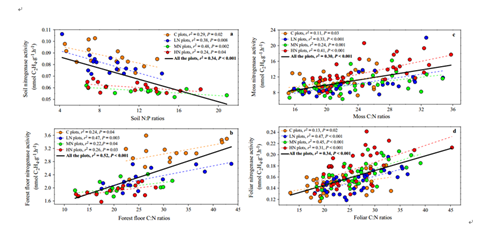Lowland tropical forests with chronic nitrogen (N) deposition and/or abundant N-fixing organisms are commonly rich in N relative to other nutrients. The tropical N richness introduces a paradoxical relationship in which many tropical forests sustain high rates of asymbiotic N fixation despite the soil N richness and the higher energy cost of N fixation than of soil N uptake. However, the mechanism underlying this phenomenon remains unclear. Dr. Mianhai Zheng and his colleagues, under the guidance of Prof. Jiangming Mo, conducted a chronic N-addition experiment in a N-saturated tropical forest in southern China and measured the N fixation rates, carbon (C), N, and phosphorus (P) concentrations, and stoichiometry in different substrates (soil, forest floor, mosses, and canopy leaves).
They found that total N fixation rates were high (10.35?12.43 kg N ha-1 yr-1) in this N-saturated forest because of the high substrate C:N and N:P stoichiometry (which explained 13-52% of the variation in N fixation). Atmospheric N deposition (34?50 kg N ha-1 yr-1) failed to down-regulate asymbiotic N fixation in this forest. They further found the insensitivity of N fixation in all the tested substrates to low N addition (50 kg N ha-1 yr-1); however, medium and high N addition (100?150 kg N ha-1 yr-1) stimulated the moss and foliar N fixation because of the increases in substrate C:N stoichiometry (which explained 30-34% of the variation in N fixation). These results emphasize the importance of substrate (particularly mosses and foliage) stoichiometry as a driver of asymbiotic N fixation and sustained N richness in lowland tropical forests.
The above findings have been published online in Ecology, with the linked paper below: https://esajournals.onlinelibrary.wiley.com/doi/abs/10.1002/ecy.2416

Figure 1. Substrate stoichiometry controls asymbiotic nitrogen fixation
